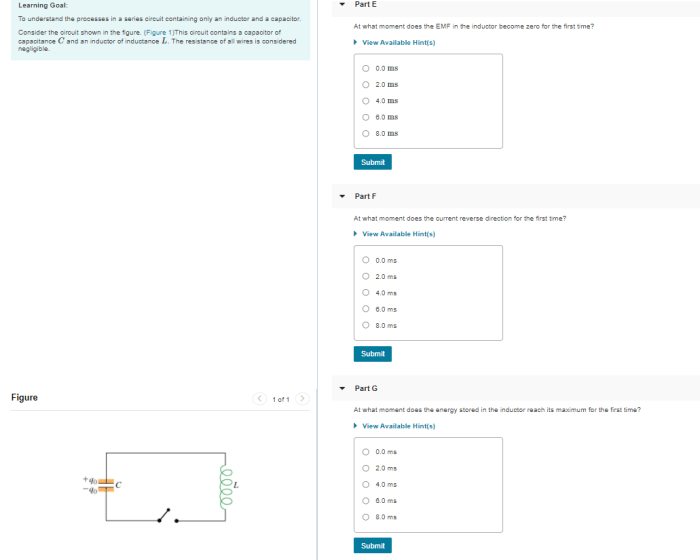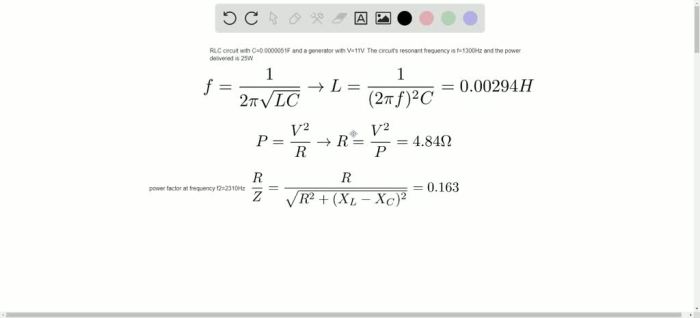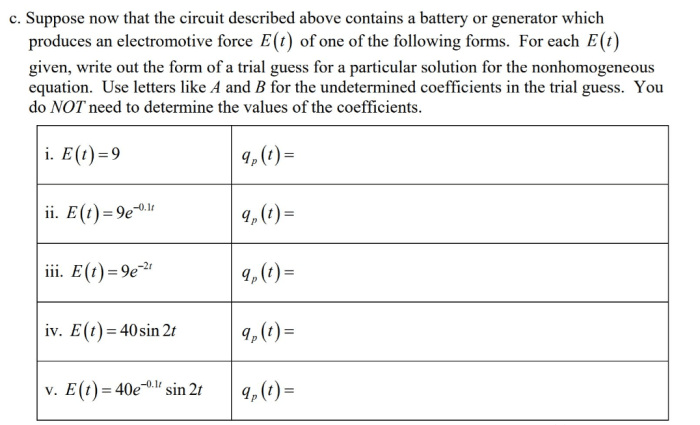A series circuit contains a generator – A series circuit containing a generator presents a fascinating interplay of current, voltage, and resistance, forming the cornerstone of many electrical systems. In this circuit, the generator acts as the driving force, dictating the flow of electrons and shaping the electrical characteristics of the circuit.
Join us as we delve into the intricacies of this fundamental electrical configuration.
Delving deeper into the series circuit, we will explore the role of the generator in regulating current and voltage, unraveling the mathematical relationships that govern these parameters. We will also shed light on the practical applications of series circuits, highlighting their advantages and limitations.
Furthermore, we will provide troubleshooting tips and discuss the use of simulation software for analyzing and designing series circuits.
Introduction

A series circuit is a circuit in which the components are connected in a single loop. This means that the current flows through each component in turn, and the total resistance of the circuit is the sum of the resistances of the individual components.The
components of a series circuit are:
- A source of electrical energy, such as a battery or a generator
- A conductor, such as a wire
- A resistor, which is a device that impedes the flow of current
- A switch, which is a device that can open or close the circuit
Generator in a Series Circuit
In a series circuit, a generator is an essential component that provides the electromotive force (EMF) necessary to drive current through the circuit. It acts as an energy source, converting mechanical or chemical energy into electrical energy.
Role of a Generator
The generator’s primary role is to maintain a potential difference across the circuit, which drives the flow of charge. Without a generator, the circuit would be incomplete, and no current would flow. The generator’s EMF counteracts the opposing forces within the circuit, such as resistance and back EMF, to establish and sustain the current.
Effect on Current and Voltage
The generator’s EMF directly influences the current and voltage in the circuit. The greater the EMF, the higher the current that flows through the circuit. This relationship is described by Ohm’s law, which states that the current (I) is directly proportional to the EMF (E) and inversely proportional to the resistance (R): I = E/R.
Similarly, the EMF also affects the voltage (V) across the circuit. The voltage is equal to the product of the current and the resistance: V = IR. Therefore, by controlling the EMF, the generator can regulate both the current and voltage in the series circuit.
Current and Voltage in a Series Circuit
In a series circuit, the current through each component is the same. This is because the electrons have only one path to follow. The voltage across each component, however, can be different. The total voltage across the circuit is the sum of the voltages across each component.
The relationship between current, voltage, and resistance in a series circuit is given by Ohm’s law:
I = V / R
where:
- I is the current in amps
- V is the voltage in volts
- R is the resistance in ohms
This equation can be used to calculate the current, voltage, or resistance in a series circuit if you know the other two values.
Calculating Current
To calculate the current in a series circuit, you can use the following formula:
I = V / R
where:
- I is the current in amps
- V is the voltage in volts
- R is the resistance in ohms
For example, if you have a series circuit with a voltage of 12 volts and a resistance of 6 ohms, the current in the circuit would be 2 amps.
Calculating Voltage
To calculate the voltage across a component in a series circuit, you can use the following formula:
V = I
R
where:
- V is the voltage in volts
- I is the current in amps
- R is the resistance in ohms
For example, if you have a series circuit with a current of 2 amps and a resistance of 6 ohms, the voltage across the component would be 12 volts.
Calculating Resistance
To calculate the resistance in a series circuit, you can use the following formula:
R = V / I
where:
- R is the resistance in ohms
- V is the voltage in volts
- I is the current in amps
For example, if you have a series circuit with a voltage of 12 volts and a current of 2 amps, the resistance in the circuit would be 6 ohms.
Power and Energy in a Series Circuit: A Series Circuit Contains A Generator

In a series circuit, power and energy are important concepts that describe the flow and consumption of electrical energy. Power measures the rate at which energy is transferred or consumed, while energy represents the total amount of work done or energy transferred over time.
Calculating Power in a Series Circuit, A series circuit contains a generator
The power (P) in a series circuit is the product of the current (I) flowing through the circuit and the voltage (V) across the circuit. This relationship is expressed by the formula:
P = IV
Where:
- P is the power in watts (W)
- I is the current in amperes (A)
- V is the voltage in volts (V)
Calculating Energy in a Series Circuit
The energy (E) consumed in a series circuit is the product of the power (P) and the time (t) over which the power is consumed. This relationship is expressed by the formula:
E = Pt
Where:
- E is the energy in joules (J)
- P is the power in watts (W)
- t is the time in seconds (s)
Applications of Series Circuits

Series circuits find practical applications in various electrical systems and devices. They offer specific advantages and disadvantages, making them suitable for certain applications.
Advantages of Series Circuits
- Simplicity:Series circuits are relatively easy to design and construct, with components connected in a straightforward manner.
- Current Control:The current flowing through all components in a series circuit is the same, providing precise control over current flow.
- Voltage Distribution:The voltage across each component in a series circuit is proportional to its resistance, allowing for controlled voltage distribution.
Disadvantages of Series Circuits
- Single Point of Failure:If any component in a series circuit fails, the entire circuit will cease to function.
- Limited Power Distribution:Series circuits have a lower power distribution capacity compared to parallel circuits.
- Voltage Drop:As current flows through each component in a series circuit, there is a voltage drop across each component, which can limit the overall voltage available.
Troubleshooting Series Circuits

Troubleshooting series circuits involves identifying and fixing faults that prevent the circuit from functioning correctly. Common problems include:
Open circuits
A break in the circuit, causing no current flow.
Short circuits
A low-resistance path, allowing excessive current flow.
Incorrect component values
Resistors with incorrect resistance, affecting current and voltage distribution.
Loose connections
Poor contact between components, causing voltage drops and resistance.
Identifying Faults
To identify faults, use a multimeter to measure voltage and current at various points in the circuit. Compare the readings with expected values to pinpoint the faulty component.
Fixing Faults
Open circuits
Repair or replace the broken wire or component.
Short circuits
Locate and eliminate the low-resistance path, such as a wire touching another wire.
Incorrect component values
Replace the resistor with the correct value.
Loose connections
Tighten the connections or replace the component if necessary.
Simulation and Analysis
Simulation software plays a crucial role in analyzing series circuits, allowing engineers and students to model and study their behavior without the need for physical components.
To create and simulate a series circuit using simulation software, follow these steps:
Creating a Series Circuit
- Select a circuit simulation software, such as LTspice, Multisim, or PSpice.
- Create a new project and add the required components (e.g., resistors, voltage source).
- Connect the components in series using wires or traces.
- Set the values of the components as needed.
- Configure the simulation parameters (e.g., time step, stop time).
Simulating the Circuit
- Run the simulation to calculate the circuit’s behavior.
- Analyze the results, such as voltage, current, and power, using the software’s built-in tools.
- Plot graphs or view tables to visualize the circuit’s performance.
- Modify the circuit parameters and re-run the simulation to explore different scenarios.
Simulation software provides valuable insights into the behavior of series circuits, enabling engineers to optimize designs, troubleshoot issues, and predict performance under various conditions.
Question & Answer Hub
What is the primary function of a generator in a series circuit?
The generator acts as the driving force in a series circuit, providing the electromotive force (EMF) that causes current to flow through the circuit.
How does a generator affect the current in a series circuit?
The generator’s EMF directly influences the current in the circuit, with a higher EMF resulting in a higher current.
What is the relationship between voltage, current, and resistance in a series circuit?
In a series circuit, the voltage, current, and resistance are related by Ohm’s law: V = IR, where V is the voltage, I is the current, and R is the resistance.